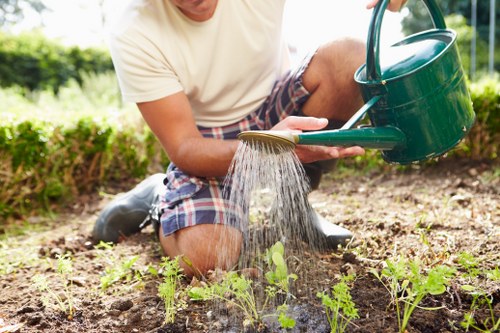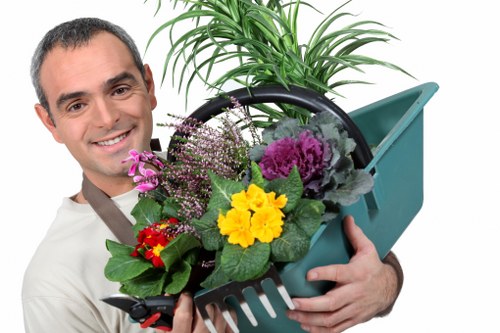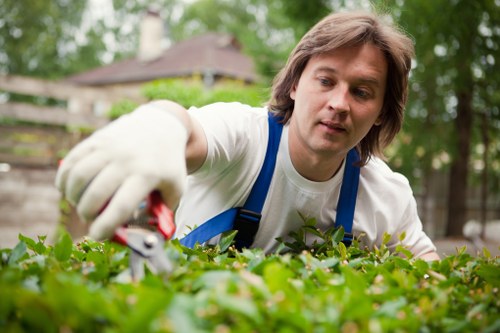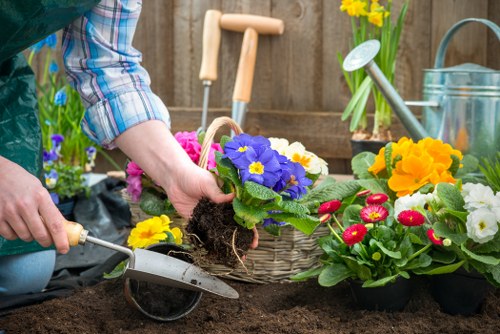Enhancing Hampstead’s Beauty: A Comprehensive Guide to Landscape Gardening
Introduction to Landscape Gardening in Hampstead

Hampstead, with its charming streets and picturesque vistas, offers a perfect canvas for landscape gardening. Whether you're a seasoned gardener or a novice, transforming your outdoor space can bring immense satisfaction and beauty to your home.
Landscape gardening in Hampstead involves a harmonious blend of natural elements, thoughtful design, and sustainable practices. The unique climate and rich soil of the area provide an ideal environment for a variety of plants and garden styles.
In this guide, we'll explore the key aspects of creating and maintaining a stunning garden in Hampstead, from selecting the right plants to optimizing your garden's layout for both aesthetic appeal and functionality.
Benefits of Landscape Gardening in Hampstead

Engaging in landscape gardening offers numerous benefits that go beyond mere visual enhancement. Here are some of the key advantages:
- Increased Property Value: A well-maintained garden can significantly boost the value of your property.
- Enhanced Well-being: Spending time in a beautifully landscaped garden can reduce stress and improve mental health.
- Environmental Impact: Gardens contribute to better air quality, support local wildlife, and promote biodiversity.
- Personal Satisfaction: Creating and nurturing a garden provides a sense of accomplishment and joy.
Furthermore, landscape gardening can serve as a personal retreat, offering a peaceful space to relax and unwind amidst nature.
In Hampstead, where green spaces are highly valued, investing in landscape gardening ensures your garden complements the neighborhood’s natural beauty.
Design Ideas for Hampstead Gardens

When designing your garden in Hampstead, consider the local architectural styles and the natural surroundings. Here are some popular design ideas:
- English Cottage Garden: Characterized by a mix of colorful flowers, climbing plants, and rustic elements.
- Modern Minimalist: Focuses on clean lines, structured layout, and a limited color palette.
- Wildlife Garden: Designed to attract birds, butterflies, and other local fauna with native plants.
- Water Features: Incorporating ponds, fountains, or streams to add tranquility and visual interest.
Choosing a design that resonates with your personal style while complementing Hampstead’s aesthetic ensures a cohesive and appealing garden space.
Additionally, integrating elements like pergolas, garden paths, and seating areas can enhance both the functionality and charm of your garden.
Plant Selection for Hampstead Gardens

Selecting the right plants is crucial for a thriving garden in Hampstead’s climate. Consider the following categories:
- Perennials: Plants that return year after year, such as lavender, peonies, and hostas.
- Annuals: Seasonal flowers that provide vibrant color, like petunias and marigolds.
- Shrubs and Trees: For structural elements, choose species like boxwood, azaleas, and magnolias.
- Climbing Plants: Ideal for trellises and walls, including ivy, roses, and clematis.
Incorporating a mix of these plants ensures a dynamic and resilient garden that can adapt to seasonal changes while maintaining year-round interest.
Additionally, opting for native plants can enhance sustainability and support local ecosystems, contributing to a greener Hampstead.
Sustainable Practices in Landscape Gardening

Embracing sustainability in your garden not only benefits the environment but also ensures the longevity and health of your plants. Here are key sustainable practices:
- Water Conservation: Implement rainwater harvesting systems and use drip irrigation to minimize water usage.
- Composting: Recycle garden waste and kitchen scraps to create nutrient-rich compost for your plants.
- Organic Gardening: Avoid chemical pesticides and fertilizers, opting instead for natural alternatives.
- Native Plants: Choose plants adapted to the local climate, reducing the need for excessive maintenance and resources.
By integrating these practices, your landscape garden in Hampstead can become a model of eco-friendly gardening, promoting a healthier environment and sustainable living.
Furthermore, sustainable gardening techniques often lead to cost savings and a more resilient garden that can better withstand pests and climate variations.
Local Considerations for Landscaping in Hampstead

Hampstead's unique environment and community standards should influence your gardening decisions. Important local considerations include:
- Soil Quality: Understanding your soil type can help in selecting appropriate plants and soil amendments.
- Climate: Hampstead experiences temperate conditions, so choose plants that thrive in such climates.
- Community Guidelines: Ensure your garden complies with local regulations, especially if you live in a conservation area.
- Local Flora: Incorporate native plants to support local wildlife and reduce maintenance efforts.
Additionally, being mindful of neighboring properties can influence the design and layout of your garden, fostering good relationships within the community.
Taking these factors into account ensures that your landscape garden not only enhances your property but also aligns with Hampstead’s overall aesthetic and environmental standards.
Hiring Professional Landscape Gardeners in Hampstead

For those seeking expertise, hiring professional landscape gardeners in Hampstead can make a significant difference. Professionals bring extensive knowledge and experience, ensuring a high-quality garden. Consider the following when hiring:
- Portfolio: Review the gardener's previous work to assess their style and expertise.
- References: Check testimonials from past clients to gauge satisfaction levels.
- Services Offered: Ensure the gardener provides the specific services you need, from design to maintenance.
- Cost: Understand the pricing structure and ensure it fits within your budget.
Investing in a professional can save time and ensure your garden is designed and maintained to the highest standards, reflecting Hampstead’s distinctive charm.
Moreover, professionals can offer valuable insights into plant selection, sustainable practices, and innovative design ideas tailored to your specific landscape needs.
Maintenance Tips for a Thriving Hampstead Garden

Regular maintenance is essential for keeping your landscape garden in Hampstead vibrant and healthy. Here are some essential tips:
- Watering: Ensure plants receive adequate moisture, especially during dry spells.
- Pruning: Regularly trim shrubs and trees to promote healthy growth and shape.
- Weeding: Remove weeds promptly to prevent them from competing with your plants for nutrients.
- Fertilizing: Use appropriate fertilizers to provide necessary nutrients.
Implementing a consistent maintenance routine helps in identifying and addressing issues early, ensuring your garden remains in top condition.
Additionally, seasonal tasks such as mulching in the autumn and planting annuals in the spring can keep your garden dynamic and responsive to changing weather conditions.
Creating Outdoor Living Spaces

Transforming your garden into an outdoor living space enhances its usability and enjoyment. Consider incorporating elements such as:
- Patios and Decks: Provide areas for dining, lounging, and entertaining guests.
- Fire Pits: Add warmth and a focal point for evening gatherings.
- Lighting: Use garden lights to create ambiance and improve safety during nighttime.
- Seating Areas: Comfortable seating encourages relaxation and prolonged use of the garden.
Integrating these features can turn your landscape garden into an extension of your home, offering a serene retreat and a space for social activities.
Designing outdoor living spaces with functionality and aesthetics in mind ensures they complement the overall landscape, providing both beauty and practicality.
Seasonal Planting Strategies

Adapting your planting strategies to the seasons ensures your garden remains attractive year-round. Here are some seasonal tips:
- Spring: Plant bulbs, shrubs, and annuals to introduce vibrant colors.
- Summer: Focus on maintenance, watering, and planting heat-tolerant species.
- Autumn: Prepare your garden for winter by mulching and planting hardy perennials.
- Winter: Protect sensitive plants and plan for the upcoming gardening season.
By synchronizing your gardening activities with the seasons, you can ensure continuous growth and beauty, making your Hampstead garden a seasonal showcase.
Additionally, seasonal planting can attract different wildlife, enriching your garden’s ecosystem and diversity.
Integrating Hardscapes and Softscapes

A balanced garden incorporates both hardscapes and softscapes. Hardscapes refer to the non-living elements such as paths, walls, fences, and structures, while softscapes encompass the living plant materials.
- Paths and Walkways: Guide visitors through your garden and define different areas.
- Walls and Fences: Provide structure and privacy, and can serve as supports for climbing plants.
- Garden Structures: Features like pergolas, gazebos, and arbors add visual interest and functionality.
- Plant Beds and Borders: Define spaces and highlight specific plantings.
Integrating these elements creates a cohesive and well-organized garden, enhancing both its beauty and usability.
Thoughtful placement of hardscape elements can also improve accessibility and provide focal points, making your Hampstead garden both inviting and practical.
Choosing the Right Garden Tools

Having the right tools is essential for effective landscape gardening. Invest in quality tools that make gardening tasks easier and more efficient:
- Hand Tools: Essential for planting, weeding, and pruning. Include trowels, pruners, and hand forks.
- Power Tools: For larger tasks, consider hedge trimmers, lawnmowers, and tillers.
- Watering Equipment: Reliable hoses, sprinklers, and watering cans ensure your plants receive adequate moisture.
- Safety Gear: Gloves, knee pads, and protective eyewear keep you safe while gardening.
Proper maintenance and storage of your garden tools can extend their lifespan and ensure they remain effective for your gardening needs.
Additionally, using ergonomic tools reduces strain and enhances your gardening experience, making it more enjoyable and sustainable in the long run.
Incorporating Sustainable Features

Incorporating sustainable features into your garden not only benefits the environment but also enhances the functionality of your space:
- Rain Gardens: Designed to manage rainwater runoff and reduce erosion.
- Solar Lighting: Eco-friendly lighting options that harness solar energy.
- Compost Bins: Facilitate the recycling of organic waste into valuable compost.
- Green Roofs: Utilize rooftop spaces for additional plantings, improving insulation and reducing heat.
These features contribute to a more sustainable and resilient garden, aligning with eco-friendly practices and reducing your environmental footprint.
Moreover, sustainable features can lead to cost savings over time by lowering water usage and energy consumption.
Conclusion: Transform Your Hampstead Garden Today

Embarking on a landscape gardening journey in Hampstead offers endless possibilities for creating a stunning and sustainable outdoor space. By understanding the local environment, selecting the right plants, and integrating thoughtful design elements, you can transform your garden into a personal sanctuary.
- Explore diverse garden designs that reflect your personal style.
- Select a variety of plants that thrive in Hampstead’s climate.
- Adopt sustainable gardening practices to support the environment.
- Consider professional assistance to achieve your gardening goals.
With dedication and creativity, your Hampstead garden can become a beautiful extension of your home, offering relaxation, beauty, and a connection to nature.
Contact us today to start your landscape gardening project and bring your dream garden to life!

